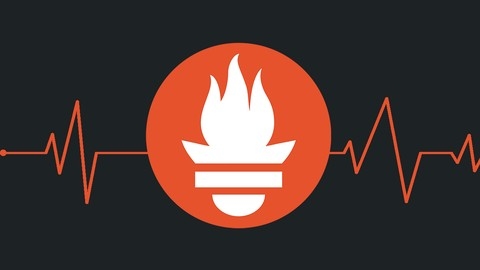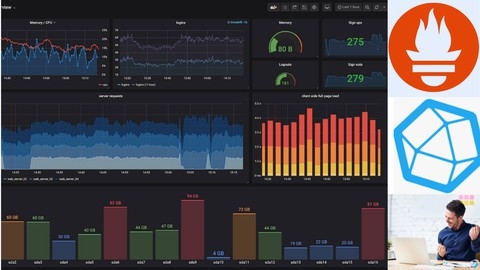Prometheus is a powerful open-source monitoring and alerting toolkit that has become essential for DevOps and SRE teams.
It allows you to collect metrics from your applications and infrastructure, query them in real-time, and configure alerts based on specific conditions.
Learning Prometheus can significantly enhance your ability to monitor the health and performance of your systems, enabling you to identify and resolve issues proactively, ultimately leading to improved stability and reliability.
Finding the right Prometheus course on Udemy, however, can feel like navigating a labyrinth.
You’re searching for a course that not only covers the fundamentals but also delves into practical applications, equipping you with the skills and knowledge to confidently implement and manage Prometheus in a real-world environment.
You want a course that’s engaging, well-structured, and taught by experienced instructors who can guide you through the complexities of this powerful tool.
Based on our extensive review of numerous Udemy courses, we’ve identified Monitoring and Alerting with Prometheus as the best course overall.
This course offers a comprehensive and hands-on approach, guiding you from the basics of Prometheus installation and configuration to advanced topics such as monitoring web applications, securing your Prometheus server, and integrating with other tools like Grafana and Kubernetes.
It’s a fantastic choice for those seeking a thorough understanding of Prometheus and its practical applications.
While Monitoring and Alerting with Prometheus is our top recommendation, there are other excellent courses available on Udemy that cater to different learning styles and specific needs.
So keep reading to explore our curated list of the best Prometheus courses on Udemy, each with its own strengths and areas of focus.
Monitoring and Alerting with Prometheus
This course takes you from the basics of Prometheus to confidently monitoring complex systems.
You begin by installing and configuring Prometheus, learning how to set up a server and use configuration files.
You quickly dive into hands-on experience, learning to use tools like node exporter to monitor your Linux and Windows servers.
You learn the inner workings of Prometheus, including its architecture and key concepts like querying and service discovery.
You discover how to monitor your web applications written in Python Flask and Java Spring Boot, going beyond basic metrics to even calculate the Apdex score, a measure of user satisfaction.
The course doesn’t stop at theory; you learn by doing.
For example, you will set up TLS and authentication to secure your Prometheus server, ensuring your monitoring system is safe and reliable.
Finally, you will explore how Prometheus integrates with other powerful tools.
You learn how to send your Prometheus data to Cloudwatch for centralized logging and monitoring, use Grafana to visualize your data in insightful dashboards, and even integrate with Kubernetes to monitor your containerized applications.
You also explore Prometheus’s capabilities for scraping Kubernetes services, integrating with Consul for dynamic service discovery, and even setting up automatic discovery of Amazon EC2 instances.
Prometheus | The Complete Hands-On for Monitoring & Alerting
This course takes you on a journey from the foundations of Prometheus to its advanced applications.
You’ll begin by unraveling the architecture of Prometheus and comprehending its inner workings.
You’ll then install and configure Prometheus on a virtual machine, gaining hands-on experience with its user interface and configuration file.
The course dives deep into PromQL, the powerful query language that Prometheus uses.
You’ll explore data types, selectors, operators, and functions, learning how to craft intricate queries to extract meaningful insights from your monitoring data.
You’ll also learn how to use client libraries in Python and Go to instrument your applications, exposing crucial metrics like counters, gauges, summaries, and histograms, for a panoramic view of your application’s performance.
You’ll delve into the world of Recording Rules, crafting calculated metrics from your existing data.
This enables you to create insightful alerts by setting specific conditions and configuring Alertmanager to seamlessly route them to notification tools like Gmail, Slack, and PagerDuty.
The course equips you to manage these alerts effectively, mastering techniques like grouping, throttling, inhibiting, and silencing.
Beyond the basics, you’ll explore the integration of Prometheus with Amazon Web Services (AWS), learning how to set up Prometheus on an EC2 instance and utilize the AWS Cloudwatch Exporter.
You’ll discover Blackbox Exporter, a tool for probing the health of external services and Pushgateway, a mechanism for pushing metrics from short-lived applications.
Finally, you’ll tap into the power of Grafana, building insightful dashboards to visualize your Prometheus data, culminating in a comprehensive understanding of Prometheus, empowering you to build robust monitoring and alerting systems.
Prometheus Alerting and Monitoring
You start by installing a dedicated Prometheus server and learn to protect it using a reverse proxy with Nginx, SSL encryption, and basic authentication.
You then discover how to collect data from different sources using techniques like scraping targets and setting up an external Node Exporter.
The course teaches you to manage this data effectively, including understanding how to delete unnecessary time series.
You dive deep into PromQL, learning to craft powerful queries for analyzing your metrics.
You then leverage this knowledge to create custom recording rules for storing calculated metrics and alerting rules to notify you of critical situations.
The course guides you through configuring the Prometheus Alertmanager to send out alerts via email using SMTP.
Finally, you learn to visualize your data using Grafana.
You connect Grafana to your Prometheus server as a data source and start building custom dashboards to monitor your systems effectively.
This course equips you with a strong foundation in Prometheus, empowering you to proactively monitor your applications and systems.
Master DevOps Monitoring with Prometheus
This course takes you from the ground up, starting with the basics of Prometheus, a powerful tool for monitoring your systems.
You’ll discover its history and why it’s a favorite in the world of DevOps.
You’ll also learn how to set up your workspace using tools like VirtualBox, Ubuntu, Visual Studio Code, and Docker.
You’ll then delve into the core principles of monitoring, including the stages of monitoring in the DevOps lifecycle, common patterns and anti-patterns, and the relationship between logs and metrics.
The course then guides you through installing and setting up a Prometheus server.
You’ll learn both terminal-based and Docker-based installation and get familiar with the Prometheus metrics format.
The course then shifts to instrumenting applications to generate metrics.
You’ll explore the different metric types, such as counters, gauges, histograms, and summaries.
You’ll discover how to name and structure metrics, and learn how to add instrumentation to a Docker web application.
You’ll also explore how to collect metrics from various sources like MySQL, GitHub, and Jira.
You’ll then uncover the power of PromQL, the Prometheus query language, learning how to aggregate, filter, and analyze data effectively using PromQL functions and operations.
You’ll discover alerting mechanisms, how to configure alerts with labels and annotations, and how to set up alert receivers like Slack, Gmail, and PagerDuty.
Finally, you’ll learn how to install, configure, and customize Grafana for visualizing your Prometheus metrics.
Ultimate Prometheus
This course equips you with the skills to monitor systems like an expert using Prometheus.
You will begin with the fundamental concepts of monitoring, grasping its significance and familiarizing yourself with the core language of Prometheus.
You will explore its architecture, learn how to install it, and navigate its user-friendly web interface.
The course then delves into the different types of metrics Prometheus uses: counters, gauges, histograms, and summaries.
You will discover how to seamlessly integrate Prometheus with your Go applications and unlock the power of PromQL, Prometheus’ query language.
This involves mastering PromQL basics, operators, and functions, enabling you to craft intricate queries for insightful data analysis.
Additionally, you will learn how to set up and configure AlertManager to define custom alerts and receive notifications through platforms like Slack.
The course then guides you through integrating Prometheus with Grafana, allowing for robust visualization and reporting.
You will learn how to deploy Prometheus seamlessly on Kubernetes using Helm and custom resource definitions (CRDs) for streamlined deployment.
You will understand the crucial role of Service Monitors in tracking the health of your services.
You’ll also explore Node Exporter, a tool used to gather valuable metrics from your servers.
The course also covers deploying and configuring AlertManager, including setting up alert rules.
Mastering Prometheus and Grafana (Including Loki & Alloy)
This course is a comprehensive guide to mastering Prometheus and Grafana, two powerful tools for monitoring and visualizing metrics.
It covers everything from installing and configuring these tools to advanced topics like alerting, security, and integrating with other technologies.
You’ll start by learning the fundamentals of telemetry and how Prometheus and Grafana fit into the monitoring ecosystem.
The course then dives into installing Prometheus on various platforms like Windows, Mac, and Ubuntu, and collecting metrics from different sources like Unix, Linux, Mac, and Windows systems.
One of the key topics covered is retrieving and working with metrics in Prometheus.
You’ll learn about the data model, data types, operators, matchers, selectors, and functions available in Prometheus.
This will give you a solid understanding of how to query and manipulate metric data effectively.
The course also covers alerting in depth, including defining alert rules, configuring Alert Manager, and integrating with tools like Slack and PagerDuty for notifications.
You’ll learn how to inhibit and silence alerts, as well as how to use recording rules in Prometheus.
Client libraries are an important aspect of instrumenting applications with Prometheus, and the course covers using client libraries for Python, Java, and .NET.
You’ll also learn about service discovery and the Push Gateway, which are essential for monitoring dynamic and short-lived jobs.
Security is a crucial consideration when working with monitoring tools, and the course covers authentication methods, enabling HTTPS, and securing Prometheus, Alert Manager, and the Push Gateway.
Moving on to Grafana, you’ll learn how to install and configure it on various platforms, including using Docker.
The course covers creating and managing dashboards, using panels and visualizations, working with variables for dynamic dashboards, and setting up alerts in Grafana.
The course also introduces you to Grafana Loki, a log aggregation system, and covers installing and using it with Promtail for ingesting log entries.
You’ll learn how to create and attach labels, visualize Loki queries on dashboards, and administer Grafana organizations, teams, and users.
Finally, the course touches on Open Telemetry and Grafana Alloy, which is a new observability platform from Grafana Labs.
You’ll learn about the architecture of Open Telemetry, sending metrics to Grafana Alloy and Prometheus, and installing and configuring Grafana Alloy on Mac and Ubuntu.
Prometheus MasterClass: Infra Monitoring & Alerting
This Prometheus MasterClass thoroughly explains how to use Prometheus to monitor your systems and applications.
You’ll start by learning the basics of Prometheus, how it works, and why it’s a popular choice for monitoring.
You’ll then learn how to install and configure Prometheus on Linux machines.
The course then explores how to use exporters like Node Exporter and MySQL Exporter to collect metrics from different sources like Linux servers and MySQL databases.
You’ll become proficient in PromQL, the powerful query language for analyzing and filtering data from Prometheus, learning how to write complex queries and create insightful visualizations.
You will then discover how to create recording rules for storing calculated metrics, simplifying your dashboards and improving query performance.
The course then delves into the crucial area of alerting in Prometheus.
You’ll learn how to set up alert rules that notify you when specific conditions are met, ensuring you’re alerted to potential problems in your systems.
You will explore how to configure Alert Manager to send alerts through various channels, such as email using GMAIL, allowing you to customize your notification workflows.
The MasterClass also covers advanced Alert Manager configurations like routing trees, ensuring your alerts reach the right teams and stakeholders.
Finally, you’ll explore Grafana, a powerful visualization tool, and learn how to create dashboards that provide a comprehensive view of your systems’ health and performance.
Grafana and Prometheus - Beginners Friendly Crash Course !
You’ll begin by learning how to install Grafana on different platforms like Linux, Windows, and Docker.
The course then dives into the Grafana user interface, giving you a thorough overview of its features and functionality.
Next, you’ll learn about Prometheus, the popular monitoring system that integrates seamlessly with Grafana.
You’ll understand Prometheus’ architecture and learn how to install it on Linux/Unix and Docker.
Additionally, you’ll learn how to set up the Prometheus Node Exporter, which is essential for monitoring system metrics.
Once you have Grafana and Prometheus up and running, the course will teach you how to configure Prometheus as a data source in Grafana.
You’ll also learn how to import pre-built dashboards and create your own custom dashboards from scratch.
The course covers various visualization types in Grafana, such as gauges, thresholds, tables, and formatting options.
You’ll learn how to use these visualizations effectively to monitor your systems and applications.
One of the standout features of this course is its coverage of Grafana’s integration capabilities.
You’ll learn how to embed Grafana panels into your website for seamless monitoring, as well as how to set up notifications and alerts using email, Telegram, and Microsoft Teams.
Additionally, the course teaches you how to monitor different components using Prometheus, including Docker containers and websites (synthetic monitoring).
Finally, you’ll learn how to connect Grafana to other data sources, such as MySQL, allowing you to visualize and monitor data from various sources in a single, unified interface.
Throughout the course, you’ll gain hands-on experience with Grafana and Prometheus, ensuring that you’re well-prepared to use these tools in real-world scenarios.








